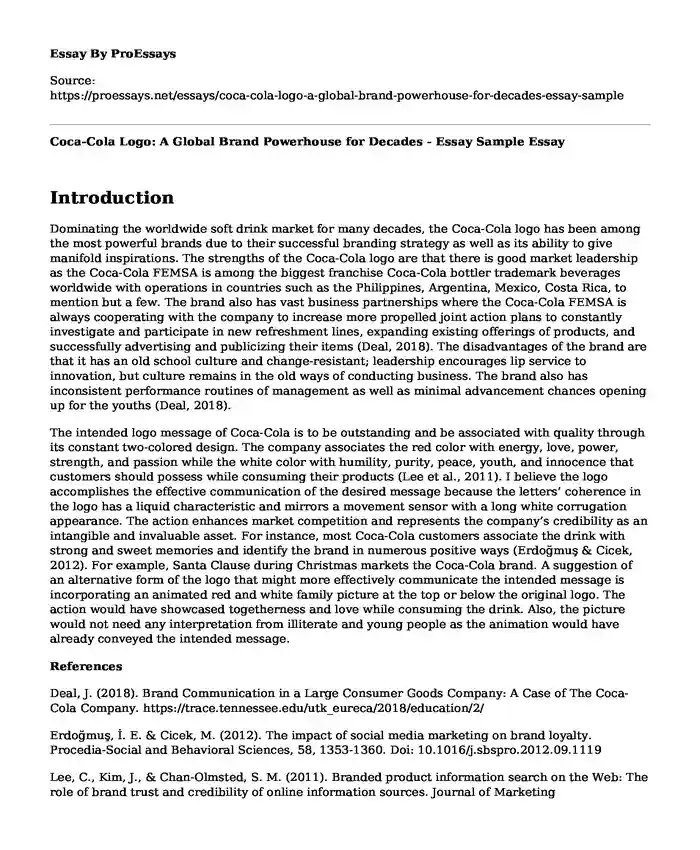Introduction
Dominating the worldwide soft drink market for many decades, the Coca-Cola logo has been among the most powerful brands due to their successful branding strategy as well as its ability to give manifold inspirations. The strengths of the Coca-Cola logo are that there is good market leadership as the Coca-Cola FEMSA is among the biggest franchise Coca-Cola bottler trademark beverages worldwide with operations in countries such as the Philippines, Argentina, Mexico, Costa Rica, to mention but a few. The brand also has vast business partnerships where the Coca-Cola FEMSA is always cooperating with the company to increase more propelled joint action plans to constantly investigate and participate in new refreshment lines, expanding existing offerings of products, and successfully advertising and publicizing their items (Deal, 2018). The disadvantages of the brand are that it has an old school culture and change-resistant; leadership encourages lip service to innovation, but culture remains in the old ways of conducting business. The brand also has inconsistent performance routines of management as well as minimal advancement chances opening up for the youths (Deal, 2018).
The intended logo message of Coca-Cola is to be outstanding and be associated with quality through its constant two-colored design. The company associates the red color with energy, love, power, strength, and passion while the white color with humility, purity, peace, youth, and innocence that customers should possess while consuming their products (Lee et al., 2011). I believe the logo accomplishes the effective communication of the desired message because the letters’ coherence in the logo has a liquid characteristic and mirrors a movement sensor with a long white corrugation appearance. The action enhances market competition and represents the company’s credibility as an intangible and invaluable asset. For instance, most Coca-Cola customers associate the drink with strong and sweet memories and identify the brand in numerous positive ways (Erdogmus & Cicek, 2012). For example, Santa Clause during Christmas markets the Coca-Cola brand. A suggestion of an alternative form of the logo that might more effectively communicate the intended message is incorporating an animated red and white family picture at the top or below the original logo. The action would have showcased togetherness and love while consuming the drink. Also, the picture would not need any interpretation from illiterate and young people as the animation would have already conveyed the intended message.
References
Deal, J. (2018). Brand Communication in a Large Consumer Goods Company: A Case of The Coca-Cola Company. https://trace.tennessee.edu/utk_eureca/2018/education/2/
Erdogmus, I. E. & Cicek, M. (2012). The impact of social media marketing on brand loyalty. Procedia-Social and Behavioral Sciences, 58, 1353-1360. Doi: 10.1016/j.sbspro.2012.09.1119
Lee, C., Kim, J., & Chan-Olmsted, S. M. (2011). Branded product information search on the Web: The role of brand trust and credibility of online information sources. Journal of Marketing Communications, 17(5), 355-374. Doi: 10.1080/13527266.2010.484128
Link to the Logo Image: https://www.coca-colaindia.com/stories/the-logo-story
Cite this page
Coca-Cola Logo: A Global Brand Powerhouse for Decades - Essay Sample. (2023, Aug 14). Retrieved from https://proessays.net/essays/coca-cola-logo-a-global-brand-powerhouse-for-decades-essay-sample
If you are the original author of this essay and no longer wish to have it published on the ProEssays website, please click below to request its removal:
- Why I Like the Apple Stock - Essay Sample
- Coca Cola As A Multinational Beverage Company - Assignment Example
- Apple Inc. Company History and Financial Statements Paper Example
- Paper Example on Funny KFC Ad Captivates Viewers
- Essay Example on Insider Threats: Malicious or Unintentional?
- Paper Example on Walmart: Crafting an Effective Business Strategy
- Amazon's Remarkable Rise: From Books to Alexa - Essay Sample







